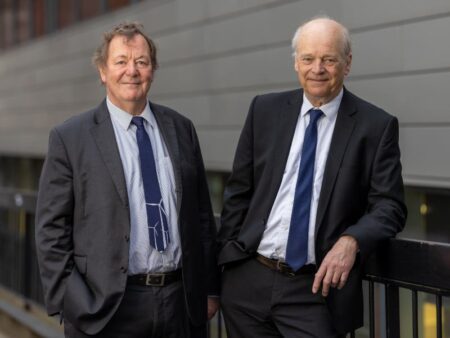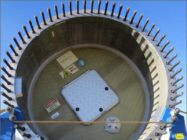
“Terrific fun” is how wind energy pioneer Andrew Garrad describes the industry’s mission to model a modern wind turbine’s wind, waves, machine and control system.
Garrad was comparing the sophisticated wind turbines of today with the more simple turbines of yesteryear when he and his fellow pioneer Henrik Stiesdal began their careers.
Garrad and Stiesdal, often called the Godfathers of wind, won the 2024 Queen Elizabeth Prize for Engineering for their foundational work to advance wind and positively impact humanity.
The two stalwarts started building wind turbines in their parent’s fields in the 70’s and since then have put in decades of dedicated service to developing wind energy.
Initially designed in 1978, Henrik Stiesdal is credited for a three-blade turbine that represents what is sometimes described as the Danish concept. He led several notable developments in proprietary blade manufacturing technology throughout the 90s, which enhanced the scale and efficiency of modern turbines.
When asked about the award, Stiesdal said humbly, “I see this, and I know that Andrew shares my view, that this is as much a recognition of what a large society of people have been able to create…what we did was a result of a big ensemble of pioneers and researchers efforts. I am a representative of an industry being acknowledged.”
Andrew Garrad pioneered the BLADED computational design tool, allowing engineers to model entire, complicated turbine systems and predict their behaviour.
Have you read?
BayWa r.e. accelerates offshore activities in Italy
ONYX Insight launches blade root monitoring solution
Said Garrad: “My contribution has been largely to do with mathematical modelling of all aspects of wind, turbines…also the modelling of the wind farms [and] forecasting to allow wind farms to bid into energy markets.”
Even though his work has touched almost all aspects of wind, Garrad’s approach is equally humble as he acknowledges the collective nature of the prize.
A new age of turbines – is bigger better?
When considering the original Danish Style, Garrad refers to it as “a simple and terrific start – a minimum of controls and a maximum of simplicity.”
“Gradually, as the turbines got bigger and bigger, they also became more and more complicated…going from something like a tractor in the early 80s to more like a giant helicopter now…,” added Garrad.
According to Garrad, the big question at the moment is whether wind turbines should become bigger.
“I think everybody would breathe a sigh of relief if they didn’t get bigger.”
Stiesdal explained that turbines increased in size out of necessity: “They did not become more complicated just because engineers like to make them like that…they got more complicated partly because we needed them to change their behaviour.”
“They changed from being a sort of disconnectable extra addition to the grid to being part of the fundamentals of the electrical grid.”
And coupled with the bigger designs turbines have become lighter and smarter as well as cheaper.
However, Stiesdal highlighted the risks of constantly developing new machines: “You are right on the boundary of what is known, sometimes you are even beyond the boundary…that, of course, has an inherent risk, that you are on the boundary of what anybody else has done before.”
In other words, while bigger means cheaper, bigger also presents the risk of going into unknown technical territory.
Stiesdal compares it to the arms race, which needed to stop at some point. Rather than going bigger, cost reduction should be achieved through mass production.
Floating offshore wind is the next quantum leap
Garrad suggested that while the wind industry overall will see only incremental improvements in the future, floating offshore wind will provide a quantum leap in terms of technology development and impact on generation.
Garrad and Stiesdal suggest that floating wind will add to the already significant success story of wind. Floating wind allows the sector to tap previously unreachable territories, where waters deeper than 70m would prove impractical and prohibitively expensive for fixed bottom wind. It allows for more democratic generation, they suggest.
Also of interest
How to embrace circularity in wind power
Site visit: Europe’s biggest offshore wind port
Floating offshore wind can also leverage lessons from the oil and gas industry to leapfrog development, said Garrad, despite an initial reticence to collaborate.
According to Garrad, “When we all started offshore wind, I think we were a bit cocky about what we were able to achieve…and the offshore oil and gas people were extremely confident, I would say arrogant [thinking] we could do anything, we are the offshore oil and gas business.”
“It took a good five years probably more for the wind people to realise it wasn’t just a wind farm offshore…it was actually something special…because it had to put up with the loads the oil and gas people were used to dealing with, but it had to be done at a cost the wind people were interested in.”
Garrad elaborated that capital cost was not an issue for floating rigs. In the wind business, however, things need to be as cheap as possible. This is why it has been critical to apply the science from oil and gas to floating wind, something the sector is getting better at.
Garrad and Stiesdal have officially retired, however, they continue to be active in the clean technology space.
Both believe they are doing something worthwhile, fighting climate change and contributing to a cleaner and greener future.
However, the two gents agree that their passion stems from “doing good things with the people you like and even having fun in the process”.
In fact, according to Garrad, “If we aren’t having fun then something is wrong”.








